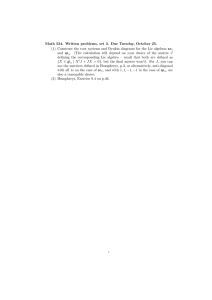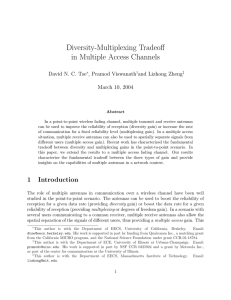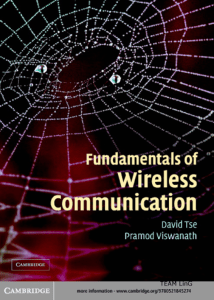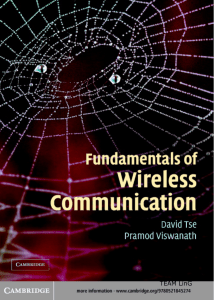STBCs with Optimal Diversity-Multiplexing Tradeoff for 2, 3 and 4
advertisement
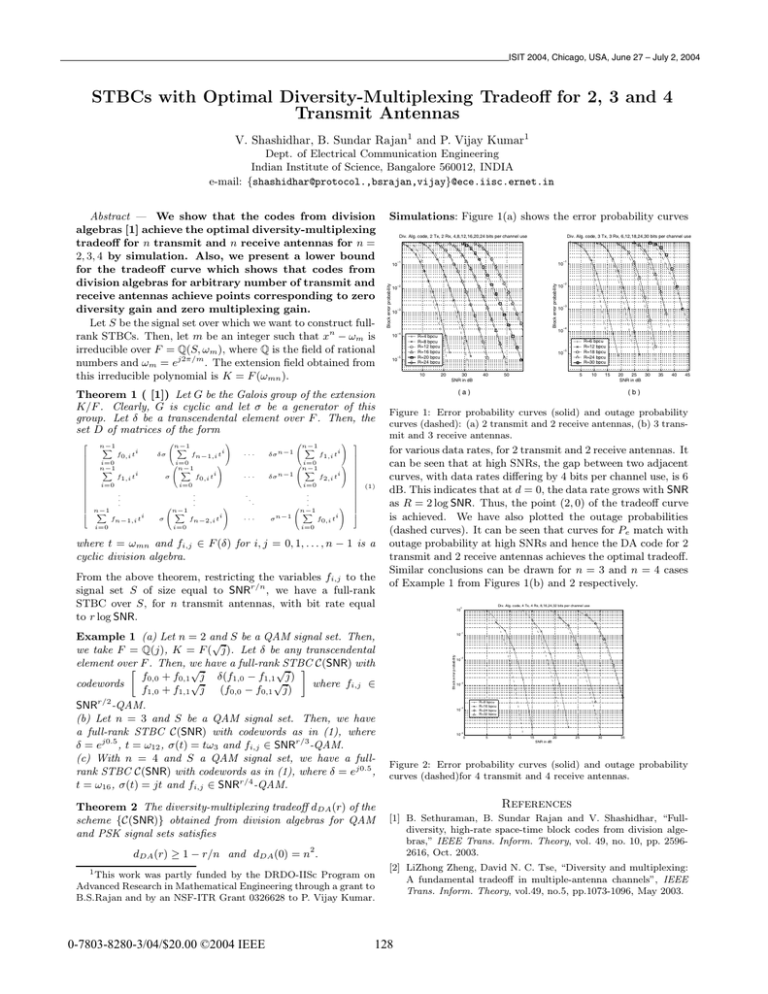
ISIT 2004, Chicago, USA, June 27 – July 2, 2004
STBCs with Optimal Diversity-Multiplexing Tradeoff for 2, 3 and 4
Transmit Antennas
V. Shashidhar, B. Sundar Rajan1 and P. Vijay Kumar1
Dept. of Electrical Communication Engineering
Indian Institute of Science, Bangalore 560012, INDIA
e-mail: {shashidhar@protocol.,bsrajan,vijay}@ece.iisc.ernet.in
2
6
6
6
6
6
6
6
6
6
6
6
6
6
6
6
6
6
4
n−1
X
i=0
n−1
X
i=0
n−1
X
i=0
i
f0,i t
i
f1,i t
.
.
.
0
1
n−1
X
i
δσ @
fn−1,i t A
1
0i=0
n−1
X
i
f0,i t A
σ@
···
i=0
0
i
fn−1,i t
···
σ@
n−1
X
i=0
.
.
.
1
i
fn−2,i t A
.
.
.
···
0
1
n−1
X
i
δσ n−1 @
f1,i t A
1
0 i=0
n−1
X
i
δσ n−1 @
f2,i t A
i=0
.
.
1
0 .
n−1
X
i
f0,i t A
σ n−1 @
i=0
3
7
7
7
7
7
7
7
7
7
7
7
7
7
7
7
7
7
5
(1)
where t = ωmn and fi,j ∈ F (δ) for i, j = 0, 1, . . . , n − 1 is a
cyclic division algebra.
From the above theorem, restricting the variables fi,j to the
signal set S of size equal to SNRr/n , we have a full-rank
STBC over S, for n transmit antennas, with bit rate equal
to r log SNR.
Example 1 (a) Let n = 2 and
√ S be a QAM signal set. Then,
we take F = Q(j), K = F ( j). Let δ be any transcendental
element over
» F . Then, we
– C(SNR) with
√ have a full-rank√STBC
f0,0 + f0,1 √j δ(f1,0 − f1,1√ j)
codewords
where fi,j ∈
f1,0 + f1,1 j (f0,0 − f0,1 j)
SNRr/2 -QAM.
(b) Let n = 3 and S be a QAM signal set. Then, we have
a full-rank STBC C(SNR) with codewords as in (1), where
δ = ej0.5 , t = ω12 , σ(t) = tω3 and fi,j ∈ SNRr/3 -QAM.
(c) With n = 4 and S a QAM signal set, we have a fullrank STBC C(SNR) with codewords as in (1), where δ = ej0.5 ,
t = ω16 , σ(t) = jt and fi,j ∈ SNRr/4 -QAM.
Theorem 2 The diversity-multiplexing tradeoff dDA (r) of the
scheme {C(SNR)} obtained from division algebras for QAM
and PSK signal sets satisfies
dDA (r) ≥ 1 − r/n and dDA (0) = n2 .
1 This
work was partly funded by the DRDO-IISc Program on
Advanced Research in Mathematical Engineering through a grant to
B.S.Rajan and by an NSF-ITR Grant 0326628 to P. Vijay Kumar.
,(((
Div. Alg. code, 2 Tx, 2 Rx, 4,8,12,16,20,24 bits per channel use
Div. Alg. code, 3 Tx, 3 Rx, 6,12,18,24,30 bits per channel use
Ŧ1
Ŧ1
10
Block error probability
10
Ŧ2
10
Ŧ3
10
Ŧ4
10
Ŧ5
10
Ŧ2
10
Ŧ3
10
Ŧ4
10
R=4 bpcu
R=8 bpcu
R=12 bpcu
R=16 bpcu
R=20 bpcu
R=24 bpcu
10
R=6 bpcu
R=12 bpcu
R=18 bpcu
R=24 bpcu
R=30 bpcu
Ŧ5
10
20
30
SNR in dB
40
50
5
10
15
20
25
30
SNR in dB
(a)
35
40
45
(b)
Figure 1: Error probability curves (solid) and outage probability
curves (dashed): (a) 2 transmit and 2 receive antennas, (b) 3 transmit and 3 receive antennas.
for various data rates, for 2 transmit and 2 receive antennas. It
can be seen that at high SNRs, the gap between two adjacent
curves, with data rates differing by 4 bits per channel use, is 6
dB. This indicates that at d = 0, the data rate grows with SNR
as R = 2 log SNR. Thus, the point (2, 0) of the tradeoff curve
is achieved. We have also plotted the outage probabilities
(dashed curves). It can be seen that curves for Pe match with
outage probability at high SNRs and hence the DA code for 2
transmit and 2 receive antennas achieves the optimal tradeoff.
Similar conclusions can be drawn for n = 3 and n = 4 cases
of Example 1 from Figures 1(b) and 2 respectively.
Div. Alg. code, 4 Tx, 4 Rx, 8,16,24,32 bits per channel use
0
10
Ŧ1
10
Block error probability
Theorem 1 ( [1]) Let G be the Galois group of the extension
K/F . Clearly, G is cyclic and let σ be a generator of this
group. Let δ be a transcendental element over F . Then, the
set D of matrices of the form
Simulations: Figure 1(a) shows the error probability curves
Block error probability
Abstract — We show that the codes from division
algebras [1] achieve the optimal diversity-multiplexing
tradeoff for n transmit and n receive antennas for n =
2, 3, 4 by simulation. Also, we present a lower bound
for the tradeoff curve which shows that codes from
division algebras for arbitrary number of transmit and
receive antennas achieve points corresponding to zero
diversity gain and zero multiplexing gain.
Let S be the signal set over which we want to construct fullrank STBCs. Then, let m be an integer such that xn − ωm is
irreducible over F = Q(S, ωm ), where Q is the field of rational
numbers and ωm = ej2π/m . The extension field obtained from
this irreducible polynomial is K = F (ωmn ).
Ŧ2
10
Ŧ3
10
R=8 bpcu
R=16 bpcu
R=24 bpcu
R=32 bpcu
Ŧ4
10
Ŧ5
10
0
5
10
15
20
25
30
35
SNR in dB
Figure 2: Error probability curves (solid) and outage probability
curves (dashed)for 4 transmit and 4 receive antennas.
References
[1] B. Sethuraman, B. Sundar Rajan and V. Shashidhar, “Fulldiversity, high-rate space-time block codes from division algebras,” IEEE Trans. Inform. Theory, vol. 49, no. 10, pp. 25962616, Oct. 2003.
[2] LiZhong Zheng, David N. C. Tse, “Diversity and multiplexing:
A fundamental tradeoff in multiple-antenna channels”, IEEE
Trans. Inform. Theory, vol.49, no.5, pp.1073-1096, May 2003.
